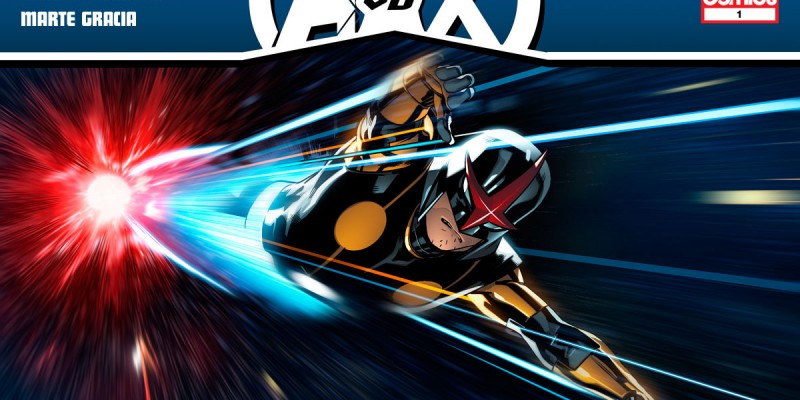Marvel Comics announced they were making some changes to their digital initiative last week, introducing a new type of online comic format they’re calling Infinite Comics. This past weekend, I attended WonderCon in Anaheim and checked out the first Infinite Comics story, a new Nova story from writer Mark Waid and penciller Stuart Immonen. Somehow, the format managed to simultaneously exceed and fail to meet my expectations — although the failure itself isn’t necessarily a bad thing.
Infinite Comics has been described as falling somewhere in between regular digital comics — comics scanned into digital form — and motion comics, which are closer to those crappy 1960s Marvel cartoons where the animators would just cut up Jack Kirby’s artwork and move it in front of a camera. A more apt description is that they are digital comics, but written and drawn expressly for the digital format, using the advantages in pacing that not being printed on paper can provide. Think of it as a comic book where you can’t accidentally spoil the book by accidentally reading the panels out of order, or skipping ahead in the book.
 If you want a slightly lower-tech preview of Infinite Comics, check out Waid and Jeremy Rock’s zombie story, Luther, available as a free PDF on Waid’s website. The Nova comic is similar to Luther, except the format is a little more self-contained, relying less on the whims of whatever PDF reader you happen to be using. But the key elements — the landscape format as opposed to portrait, the slow reveal of panels and caption/dialogue — are all basically the same. None of this is revolutionary technology. This could have been done years ago and for all I know, was. From that aspect, it’s a little disappointing. From all the hype, it was easy to expect something a little more grandiose tech-wise.
If you want a slightly lower-tech preview of Infinite Comics, check out Waid and Jeremy Rock’s zombie story, Luther, available as a free PDF on Waid’s website. The Nova comic is similar to Luther, except the format is a little more self-contained, relying less on the whims of whatever PDF reader you happen to be using. But the key elements — the landscape format as opposed to portrait, the slow reveal of panels and caption/dialogue — are all basically the same. None of this is revolutionary technology. This could have been done years ago and for all I know, was. From that aspect, it’s a little disappointing. From all the hype, it was easy to expect something a little more grandiose tech-wise.
Instead, this was more about figuring out how to write and draw comics for a digital landscape. Not create comics, then digitize them; not create poorly animated movies using comic book stories as a basis; but actually creating sequential artwork stories for a digital medium, without being beholden to how it would have worked on paper.
At the same time, these books aren’t going to translate very well to paper. At least, not the way Waid, Immonen, and Rock create their stories. Sure, they could just print out the PDF, but it’s something akin to watching Lawrence of Arabia in pan and scan on a 10″ CRT TV or trying to absorb the wonder of sculpture from a photograph of Michelangelo’s David. These are medium-specific comics, meant to be read on a digital platform where images can be replaced in an instant.
If you were expecting some giant technological leap, you may be in for a disappointment. If you’re open to a new way to ingest something closer to a traditional comic book, but created more specifically for the digital medium, you should be very, very happy.


If
creators are serious about making comics for the digital world, it
makes sense for them to adapt to the local territory and not simply
digitize comics originally meant for a printed format. That said, I’m
not convinced that we gain anyth…ing
in terms of storytelling or overall quality. As the article so rightly
points out, “it’s something akin to watching Lawrence of Arabia in pan
and scan on a 10″ CRT TV”. Digital comics may evolve into something
pretty darn cool, but if so they will be very different from what we’re
used to in printed form… and they will come with their own
limitations. The size is what bothers me most at the moment, since
digital comics are likely to be made with a tablet in mind rather than a
large screen computer (where a double-page spread could actually spread
its wings, so to speak).
The problem is you’re already wrong thinking in terms of a double page spread. That’s paper. In this case, everything is just formatted for 16:9 landscape. Which means tablets, but also phones, monitors, TVs… The problem is divorcing yourself from the idea of comic books existing as they have for the last 70s years, as a magazine-formatted paper product, with two pieces of paper facing each other in portrait. This is more like if long-form comics (because web comics are kind of a different thing, following the newspaper funnies tradition, generally require less transition) were created having never existed on paper. And I really wish I had included that in the article.
It’s not so much a gain in storytelling, as adapting to fit the environs. As I said in the article, there are some gains when it comes to pacing, holding back key information until it actually matters, but it’s nothing that is going to blow a novice to comics away, they’re only things old hands to the art form are really going to notice. That said, I’ve read all of one-and-a-half of these (Luther is similar, but slightly different), and while Waid and Immonen are masters of their craft (Rock is pretty awesome too, just new), give it some time. How long did it take the industry to get to Steranko playing with panel format?
And I damn near wrote a second article.